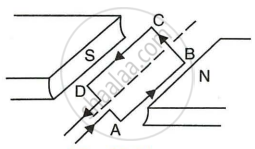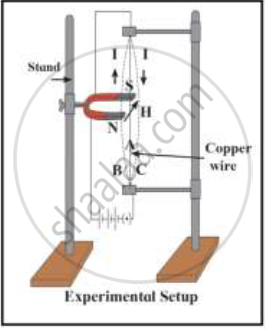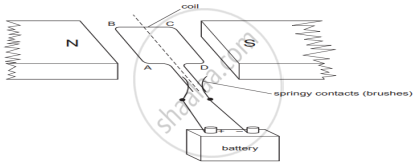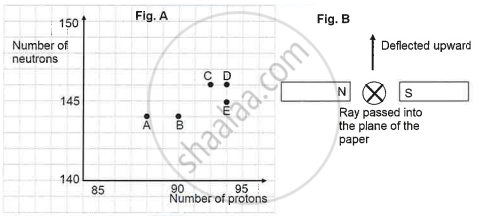Advertisements
Advertisements
Question
Which of the following property of a proton can change while it moves freely in a magnetic field? (There may be more than one correct answer.)
Options
mass
speed
velocity
momentum
Solution
velocity and momentum
Explanation:
Every charged particle moving in a magnetic field experiences a force. Fleming's left-hand rule determines the direction of the force on a positively charged particle (such as a proton). This force will alter both the velocity and momentum of the proton.
APPEARS IN
RELATED QUESTIONS
The magnetic field in a given region is uniform. Draw a diagram to represent it.
Observe the following figure:

If the current in the coil A is changed, will some current be induced in the coil B? Explain.
What concealed do you get from the observation that a current-carrying wire deflects a compass needle placed near it?
What is the shape of a current-carrying conductor whose magnetic field pattern resembles that of a bar magnet?
What is a solenoid? Draw a sketch to show the magnetic field pattern produced by a current-carrying solenoid.
What type of core should be put inside a current-carrying solenoid to make an electromagnet?
The front face of a circular wire carrying current behaves like a north pole. The direction of current in this face of circular wire is:
(a) clockwise
(b) downwards
(c) anticlockwise
(d) upwards
A current-carrying conductor is held in exactly vertical direction. In order to produce a clockwise magnetic field around the conductor, the current should passed in the conductor:
(a) from top towards bottom
(b) from left towards right
(c) from bottom towards top
(d) from right towards left
A current flows in a wire running between the S and N poles of a magnet lying horizontally as shown in Figure below:
The force on the wire due to the magnet is directed:

fron N to S
from S to N
vertically downwards
vertically upwards
State condition when magnitude of force on a current carrying conductor placed in a magnetic field is zero?
A coil ABCD mounted on an axle is placed between the poles N and S of a permanent magnet as shown in Figure.

- In which direction will the coil begin to rotate when current is passed through the coil in direction ABCD by connecting a battery at the ends A and D of the coil?
- Why is a commutator necessary for continuous rotation of the coil?
- Complete the diagram with commutator, etc. for the flow of current in the coil?
i) Which principle is explained in this figure?
ii) Which rule is used to find out the direction of a force in this principle?
iii) In which machine this principle is used? Draw a diagram showing working of that machine

A flat coil ABCD is freely suspended between the pole pieces of a U-shaped permanent magnet with the plane of coil parallel to the magnetic field.
When will the couple acting on the coil be
- maximum
- minimum?
State whether a magnetic field is associated or not around a static charge.
Which of the following factors affect the strength of force experience by current-carrying conduct in a uniform magnetic field?
A magnetic field directed in north direction acts on an electron moving in east direction. The magnetic force on the electron will act ____________.
A simple motor is made in a school laboratory. A coil of wire is mounted on an axle between the poles of a horseshoe magnet, as illustrated.

In the example above, coil ABCD is horizontal and the battery is connected as shown.
- For this position, state the direction of the force on the arm AB.
- Why does the current in the arm BC not contribute to the turning force on the coil?
Assertion (A): A magnetic field exerts a force on a moving charge in the same direction as the direction of the field itself.
Reason (R): The direction of force is given by Fleming’s left-hand rule.
Two LED bulbs of 10W and 5W are connected in series. If the current flowing through 5W bulb is 0.005A, the current flowing through 10W bulb is ______.
|
The graph (fig A) illustrates the correlation between the number of protons (x-axis) and the number of neutrons (y-axis) for elements A, B, C, D, and E in the periodic table. These elements are denoted by the letters rather than their conventional symbols. When the element C, depicted in the graph, undergoes radioactive decay, it releases radioactive rays. When these rays are directed into the plane of the paper in the presence of a magnetic field, as indicated in the fig B, they experience deflection, causing them to move upwards.
|
Name the law used to identify the radioactive radiation emitted by the element.

